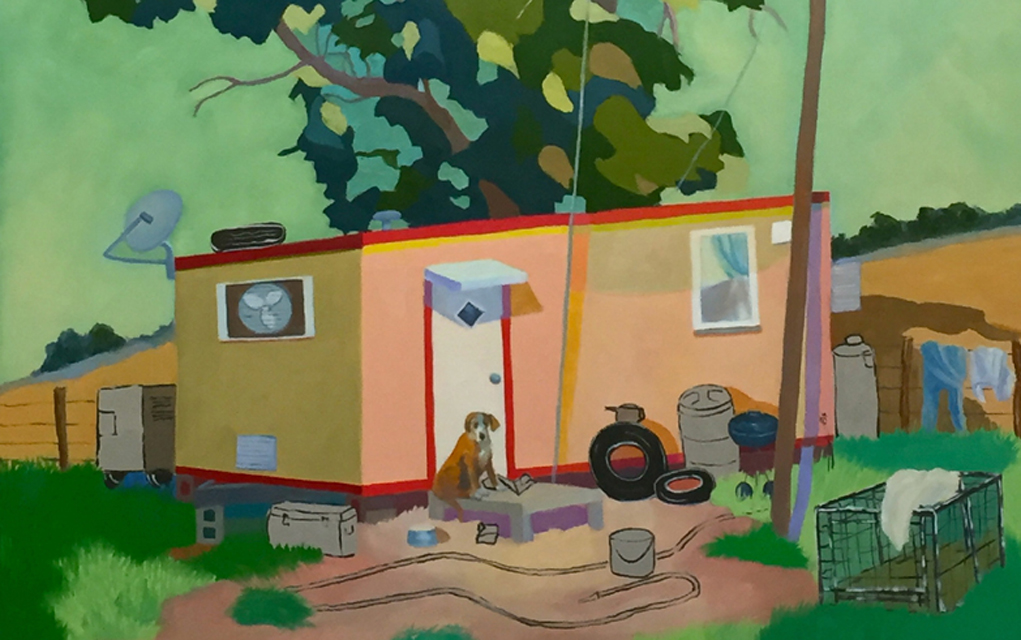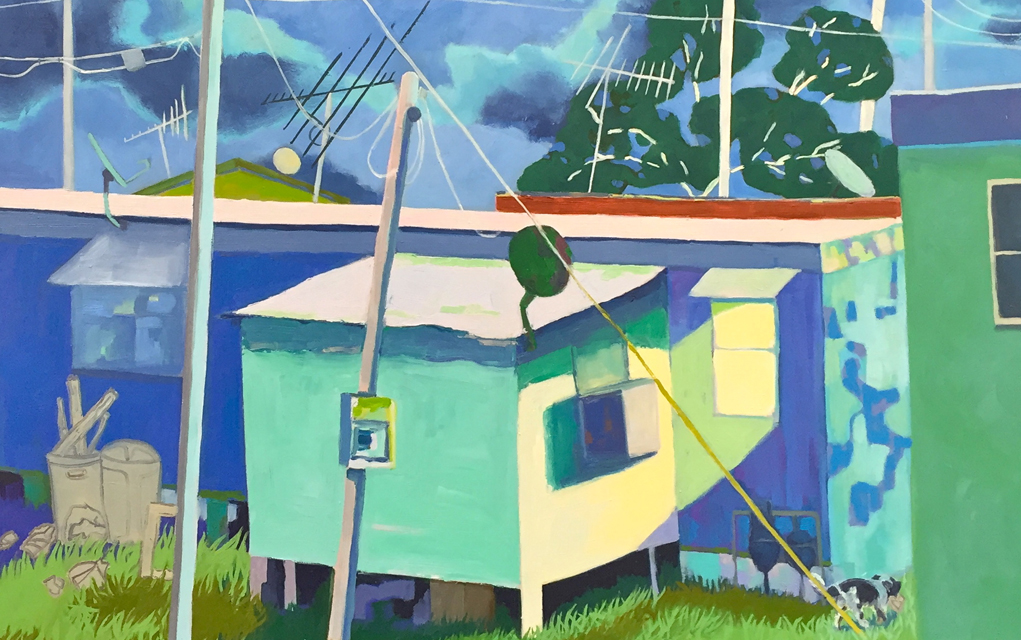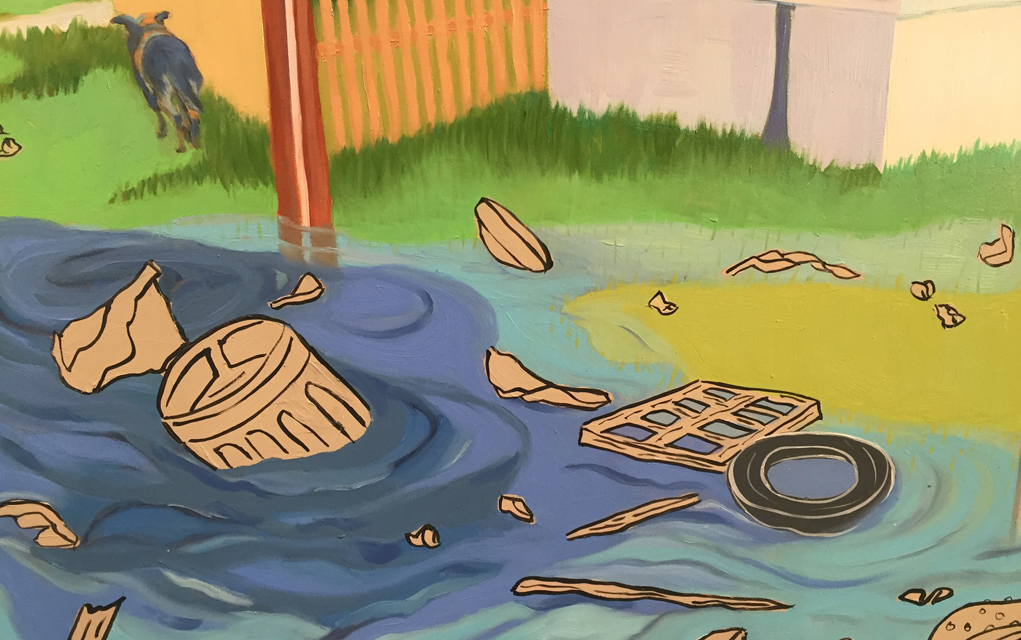
Lindy Chambers lives in rural Texas, almost halfway between Houston and Austin. She spends a lot of time by herself in her studio, outside with her animals or driving on country roads watching the scenery pass by. In those places she notices the simple things which serve as the inspiration for her work.
“As we travel the rural roads, we often prefer to see only the obvious beauty,” she writes in her artist’s statement. “My work comes from what I pass by everyday in the countryside, the dwellings of the invisibly beautiful.”

Chamber’s paintings, now on view at the Dairy Arts Center through July 4 in her exhibit Ten by Sixty, stem from a curiosity about the people living inside mobile homes, their stories, their purpose and their dreams. “Who live in these 10’ x 60’ boxes?” she asks. Who is it that lives on wheels? “Wheels can symbolize a measure of independence, and a portable American dream, ready to move at a moment’s notice with no tethers to the ground beneath them.”
The American dream usually signifies the sort of freedom that allows for upward mobility, for prosperity as achieved through hard work in a society with few barriers. For many, it is symbolized by the prospect of homeownership or retirement or the acquisition of possessions, but it is not built on notions of wealth and advancement alone. At its root, the American dream represents the intangible aspects of optimism and the innate capabilities of every individual to succeed on their own terms.
Many say that characteristic optimism is being challenged, perhaps most notably acknowledged by President Obama in his inaugural address when he urged Americans not to heed the “nagging fear that America’s decline is inevitable, and that the next generation must lower its sights.” Almost eight years later, that pessimistic outlook is still palpably familiar. However, Chambers does not portray it as grim, but rather as a beautiful return to simplicity.

The American dream, she says, is not dead or gone, it’s just hiding out of plain sight. She explains that artists are seers whose job it is to notice what the rest of us miss, to point it out and offer visual explanations.
Chambers offers that description in color and light. The initial palette for her work is inspired by the paint on the mobile homes themselves, often painted in the bright colors characteristic of Mexico, but she takes them far beyond that initial prompting. For her, color is a language capable of storytelling and she takes advantage of the vast range of pigments to tell each painting’s tale.
Inspired by color theorist Charles Hawthorne, Chambers experiences the world in color. When she first views something, she notices the contrasts between lights and darks, then moves on to other details like the shapes of objects or the shades of blue and brown in a puddle. In each painting, Chambers tries not to use the same color twice, a testament to painting what she truly sees.
Her color choices are also strategic, using it to blend together a range of styles that don’t ordinarily lie together on the same canvas. Each painting has strong elements of abstract and impressionist techniques, as well as forms that are cartoon-like in character.
The most important things are portrayed in abstract color — the trees, the homes, but mostly the animals. Chambers doesn’t include the human inhabitants in her paintings, instead their life is imbued by the character of the critters and what they say about their human hosts.
“The animals in the yards that people have are mostly goats because they are pets and food,” Chambers says. “The dogs are mostly stray and flea ridden and that is a little sad, but it is interesting that they live like that, that they don’t particularly care for the animals because it costs money, but they are a part of their homes.”
In stark contrast are the objects shown strewn about the yards — tires, cans and all kinds of trash. Each is depicted as a line drawing, painted in a consistent shade of beige that pops in contrast to the otherwise spirited color.
“I depict [the trash as] flat because they don’t see it anymore, the people living there,” Chambers says. “It’s like they walk by it all the time and they don’t see it. It’s not important, so I don’t paint it.”

But if you look closely at the trash in the paintings it is anything but forgotten. In “This is for the Birds,” pieces of beige trash float in deeply blue pools of water collecting outside of a trailer on a dirt road. An unattended dog wanders away, almost unnoticed as the eye is drawn irrevocably to the beige objects. The contrast between the color of the painting and the cartoony plainness of the floating debris brings a three dimensional sense to the paintings. From that depth comes the character of the people inside accompanied by their powerful reimaginations of the American dream , if only you pause to notice.
“The problem is we don’t stop long enough,” Chambers says. “If you just think about trash you’ll probably say, ‘Ugh it’s gross’ and ‘Ugh it’s horrible.’ But if you stop and really look at it, you won’t see it as trash, you will see beautiful patterns, interesting shapes and contrasts. It is just a matter of stopping and looking. Paying attention.”
Chambers has done more than 70 paintings of mobile homes, and a few of her more recent pieces only depict the trash that she finds there. This transition from people, to home, to trash is the evolution of the American dream as it changes from visions of fancy mansions and wealth to more humble ideals of working hard to seize the opportunities afforded.
While Chambers admires that lifestyle, it is not one that she calls her own. She lives in a big, old house out in the country and spends most of her time in her studio, her favorite place.
She says that when she hosts visitors from nearby Houston, they always comment about how dark it is out in the country, how quiet and how unnerving they find that to be. “Aren’t you afraid of the dark?” they ask.
“No, I love it,” Chambers replies.
“I used to teach people art, and I would tell them to just look into the darkness, into the blankness of space and paint what they see. ‘Don’t put anything in your head,’ I would say. And they would reply, totally anxious, ‘But I don’t see anything! I don’t see anything!’ I said ‘You will.’ And, sure enough, they might see just a line and I would say ‘OK, now draw that line.’ It’s amazing what you can see, what you can draw after a while of looking into the dark.”
On the Bill: Ten by Sixty. The Dairy Arts Center, 2590 Walnut St., Boulder, 303-440-7826. Through July 4. Exhibition reception, Friday, June 17, 5 p.m.














